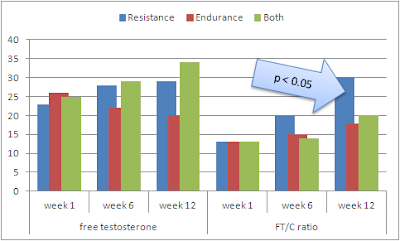Strength, cardio or both? That is the question!
We have dealt with similar topics in the past, here at the SuppVersity. Those of you who have been around for some time, will remember the 2011 study by Sahlin et al. which showed that a bout of resistance training, when would increase mitochondrial biogenesis and protein synthesis and ramp up your fatty acid metabolism, when it was performed right after an endurance training session (cf. "Doing Legs after Cardio"). On the other hand, the results of a more recent study by Rosa et al. did suggest that doing weights first would be the way to go - at least if your focus was on keeping your leptin levels up (cf. "Greater Reductions in Leptin with Weights After Cardio"). And as if things were not yet complicated enough, a much-cited meta-review by Wilson et al. appears to suggest that neither one nor the other would be a good idea (Wilson. 2011).
The study protocol: Periodized strength or "HIIT" vs. both
In the study at hand (Shakeri. 2012), Nader Shakeri and his colleagues assigned their 24 participants, who had been randomly selected from a group of 86 volunteers, to one out of three homogeneous groups. Thusly, the scientists made sure that there were no statistical siginficant differences in terms of body composition, VO2max, etc. between the three study arms:
- Endurance (interval) group: Three times per week the participants performed 4, 6 and 8 bouts of 3min cycling at 75%, 80% and 85% of their maximal heart rate in weeks 1-4, weeks 5-8 and weeks 9-12 respectively. This "quasi-HIIT" program, which obviously got intense, because the intervals were so longish, but is otherwise still different from e.g. my HIIT prescription in the templates I have provided in the last installment of the "Step by Step Guide to Your Own Workout", was preceded by an initial 5-min warm-up at 60W and followed by a short cool down [Note: There is no information about the rest periods between the intervals].
- Resistance training group: Brief warm-up, followed by a standardized leg-training routine consisting of 3 sets with 12, 8, 6 repetitions of leg presses, the leg extensions, leg curls and adductor and abductor exercises at 70%, 80% and 85% of the 1RM with 3min rest between sets; training loads were progressively increases over the 12-week study period in the course of which all participants trained three times per week.
- Concurrent training group: Same as endurance training, yet only half of the workload, with sessions comprising only one set of 10 reps of each exercise at 80% or the 1-RM and 2, 3 and 4, instead of 4, 6 and eight bouts of cycling at the given VO2max (see endurance training group for details; note: it is not quite clear from the study text, but it appears as if the strength training was performed first)
Strength for T (testosterone), both for C (cortisol)
The testosterone and cortisol responses on the other hand, are also influenced by the type of training you perform. It is thusly not really surprising that we do see an increase in total testosterone in the strength training group.
 |
| Figure 1: Total testosterone (ng/ml) and cortisol levels (nmol/ml) - left; and total testosterone to cortisol ratio - right (data adapted from Shakeri. 2012) |
Total or free testosterone - you better test for the right one!
If we consider only, the total testosterone levels (TT), conventional wisdom (see discussion at the end of this post) about the importance of the TT-toortisol (TT/C) would dictate that the high workload in weeks 6-12 would counter, or at least mitigate the beneficial effects of resistance training. After all, the TT/C ratios are significantly lower than at baseline in all, but the concurrent training group, in which the standard variation of ~50% was too large for the data to reach statistical significance (cf. figure 1, right).
 |
| Figure 2: Free testosterone (pg/ml) and free testosterone to cortisol ratio (data adapted from Shakeri. 2012) |
So, Wilson was right? Never do cardio after weights?
As I have already hinted at between the lines, the ostensibly straight-forward conclusion that these results would simply confirm what the bros have been preaching for years, i.e. "Never to cardio after weights - regardless of the type and/or volume!", is more than debatable in view of the results from Stuart Phillips' lab at the McMaster University in Canada, Ontario. After all, in their 12-week resistance exercise training study, West and Phillips found no correlation for either strength or size gains with free testosterone, but a weak yet statistically significant correlation between increases in lean body mass and cortisol (West. 2011)!
 |
| Figure 3: Correlations (blue) and p-values (red) between serum hormone levels and increases in lean body mass in the West & Phillips 12-week resistance training study (based on data from West. 2011) |
